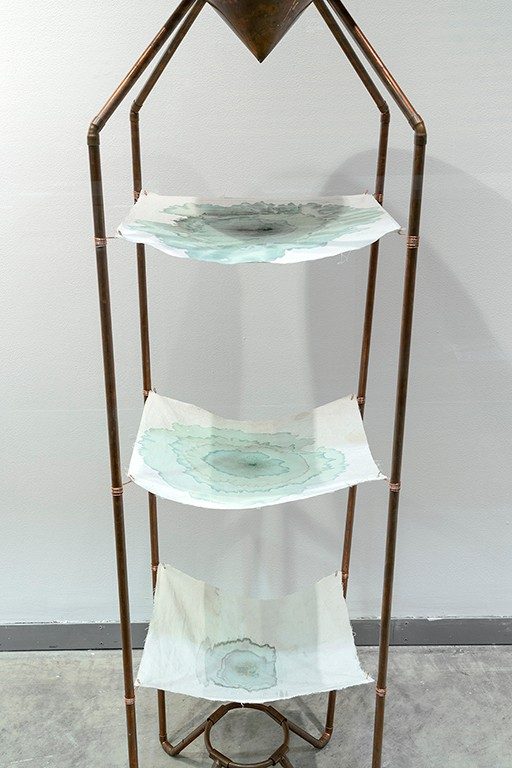COLIN COURTNEY
Proposal for Precipitation
2019–ongoing

Photo by Guy L’Heureux
Reclaimed roofing and plumbing copper, copper wire, aluminum rivets and Montreal rainwater-stained-archival-fabric, plant pigments on archival fabric.
Standing copper sculpture (72' X 16' X 16')
Fabric hanging on the wall (7' X 7')
Artist statement
The ongoing artwork Proposal for Precipitation investigates relationships between weather forces and sculptural self-authorship. This process-based sculpture is a precipitation collector that records through drips, intersecting genres of art science, landscape painting and kinetic art. As concentric fractal geometries drip from an indexical archive of collapsing climates, what can an ethos of human to non-human collaboration teach us about our collective atmosphere, and what does it mean for weather to record its own evolution?
 Photo by Guy L’Heureux
Photo by Guy L’Heureux

Photo by Guy L’Heureux
Artist’s biography
Colin Courtney is an artist working between disciplines of sculpture, painting and science. They live, work, and play on the island of Tiohtiá:ke/Montreal. Site-based learning and studio-lab experiments inform their ethos as a sensitive collaborator with materials and technologies, highlighting underlying processes such as entropic change, physics, and weather phenomena. With the rejection of colonial hierarchies that nature is a thing to be controlled or improved, the imperfect is given deserving primacy in their art. Courtney’s work has been exhibited internationally at spaces such as The Grand Rapids Public Museum Planetarium (MI), The University of British Columbia (Vancouver), and Art Mûr (Montreal).
Essay
Collaborating with the Climate
Author Renata Critton-Papp
Artist Colin Courtney
Artwork Proposal for Precipitation, 2021–ongoing
Colin Courtney’s Proposal for Precipitation is a gentle collaboration with the climate, materially recorded from several locations in Montreal. The slender tower of roofing and plumbing copper takes up temporary space, capturing the unpredictable yet constant cycles of mist, rain, hail, sleet, snow, and fog. The funnel of the structure acts as a receptacle for these conditions, collecting and digesting the water droplets and producing subtle reflections of the urban environment. Thin pieces of found cotton fabric are placed beneath the copper structure to process the chemical reactions occurring between their materiality. The rings of pigment which result from these reactions present a strong connection between the visual imprints and their sources, like the clouds that have released the precipitation reflected in the mineral, layered fractals which appear on the fabric.1 As condensation moves slowly through the structure, the acidity within the precipitation corrodes the copper metal and filters down through the cotton swatches, leaving traces of pale bluish-green and soft teal. Courtney’s intention is not to answer any questions or to search for scientific outcomes of the impacts of humanity on weather cycles. Instead, they want to leave the interpretation up to the viewer. This allows the audience a space to broaden their perspective and their appreciation for how we interact with cycles of water.
In approaching the subject of climate in their work, Courtney describes their intentional refusal to intervene with natural weather cycles. Rather, they seek to gently inquire and question, prioritizing a receptive and collaborative spirit between themselves and the atmosphere. In Proposal for Precipitation, they engage with an active curiosity, focused on materiality and an undetermined conjecture. Courtney positions their work within a liminal temporality, embracing its brief stays in many areas and its ability to be disassembled and reassembled anywhere. The malleability of the project allows for Courtney to engage with unpredictability and chance, inspired specifically by alchemy. Their artistic practice lends itself to values that are shared in alchemical laboratories of centuries past, particularly the focus on the life of materials and the cryptic recording of their transformational states. Additionally, alchemy holds a strong connection to Courtney’s accidentally created pigments; these unforeseeable results emerge from an inherent “playful experimentation.”2 This deliberate playfulness highlights how Courtney looks to interact with and consider natural forces, engaging the audience in a tangible yet fluid interpretation of weather and matter.

Ultimately, they look to a decolonial conception of time, where the oppressive need to control a linear progression of space and matter can be rethought.
The spontaneous nature of Proposal for Precipitation still leaves space for Courtney’s intentionality in constructing their work. They make use of the movement of liquids and gravity while relying on the solid copper of the structure to stand within each urban climactic location. Moreover, Courtney engages with the impacts of colonialism on the landscape, precisely the dominating and violent position which is repeatedly enacted by western powers. They look to work through and around the controlling patterns of Western imperialism that impact scientific investigations of nature. Through these rejections, Courtney’s work acts as an “intermediary between artwork and scientific inquiry,”3 positioning themselves from an observational position in regard to the climate. Ultimately, they look to a decolonial conception of time, where the oppressive need to control a linear progression of space and matter can be rethought. By acknowledging both the eternity and temporality of each moment in our climate, the artist suggests further value in aspects of the natural world. In other words, they clearly see how “minerals, trees, the disintegration of a riverbank all don’t follow predictable time scheduling”4 and attempt to reflect the intense curiosity which is held in the untethered and spontaneous actions of weather. Courtney’s work does not seek to claim ownership, instead, they offer alternative ways of existing alongside nature.
- Colin Courtney in discussion with the author, July 12, 2021.
- Ibid.
- Ibid.
- Ibid.
 Photo by Guy L’Heureux
Photo by Guy L’Heureux
Author’s biography
Renata Critton-Papp is in their fifth year as an Art History major with a minor in Interdisciplinary Studies in Sexuality at Concordia University in Tiohtiá:ke/Montreal. They are currently interested in research-creation, using many mediums to document and explore queer temporalities, recovery, and our emotional affinity towards nature.
 Photo by Guy L’Heureux
Photo by Guy L’Heureux

 Photo by Guy L’Heureux
Photo by Guy L’Heureux

